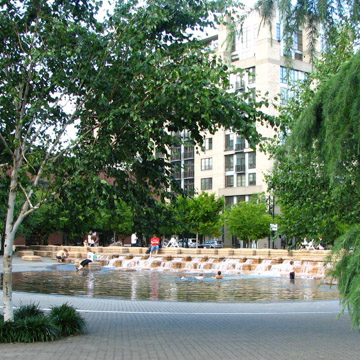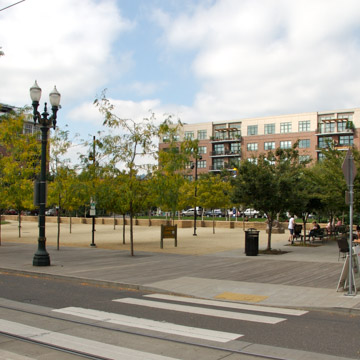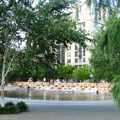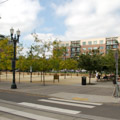Jamison Square Park is the first city park added to downtown Portland’s Pearl District following the adoption of the 2001 Pearl District Redevelopment Plan by the Portland City Council. It occupies an entire city block a few blocks west of Union Station.
The Pearl District, a former industrial area that has undergone rapid gentrification since urban renewal efforts began in the 1980s, is now a trendy, mixed-use neighborhood with a thriving arts and cultural scene. The Redevelopment Plan aimed to encourage continued development with respect to historic preservation, to diversify housing and economic opportunities, to reduce dependence on the automobile, and to enhance neighborhood amenities. The latter goal included the creation of Jamison Square Park, along with the similarly sized Tanner Springs Park two blocks north and a larger recreational area, The Fields Park, further north that connects to the waterfront parks along the Willamette River. The park designs are united by the theme of water and physically continuous wooden boardwalk of ipê planted with an allée of honey locusts, reminiscent of the city’s original raised wooden sidewalks and docks on the Willamette.
PWP Landscape Architecture designed the 200 x 200–foot Jamison Square Park, which features a semicircular lawn on the west, a central fountain, and a grove on the east with another small, circular lawn on the south end. A stepped sandstone wall bisects the site and serves simultaneously as a fountain, seating area, play structure, and sculpture. Likened to an aquifer or spring, water seeps from its cracks on a regular cycle, cascading over the stones and filling a semicircular wading pool to a depth of 12 inches. The pool then slowly drains, recirculates, and fills once again, mimicking the action of the tides, and offering active water play for children, whose parents can keep a watchful eye while resting on the sloping lawn in front of the fountain or on the stepped sandstone wall itself. Birch trees provide shade to those on the lawn, which is frequently used as a picnic spot. When the water is turned off, the sloping ground becomes a paved plaza. To the east of the fountain is a grove—a bosque inspired by European squares. It is a quiet area of compacted earth where people sometimes play bocce. The streetcar passes along Tenth and Eleventh avenues, providing easy access from other parts of the city.
Jamison Square Park sports several sculptures: 30-foot-tall Tikitotemoniki Totems by Kenny Scharf along the streetcar line; a red abstract work by Alexander Liberman set on a circular lawn beneath the bosque; and a red granite bear by Mauricio Saldaña, which is a favorite of the children who frequent the park. One can also view the fountain itself as a grand sculpture. Its zig-zag slabs share a kinship with the work of Carl Andre, and visitors have been fascinated and influenced by the park’s minimalist design, built up of circles and serial repetition of rectangles within a larger square.
Jamison Square Park is popular with locals, many of whom reside in the multi-story apartment buildings surrounding the square.
References
Gillette, Jane Brown. Peter Walker Partners: Landscape Architecture: Defining the Craft. San Francisco: ORO Editions, 2005.

















